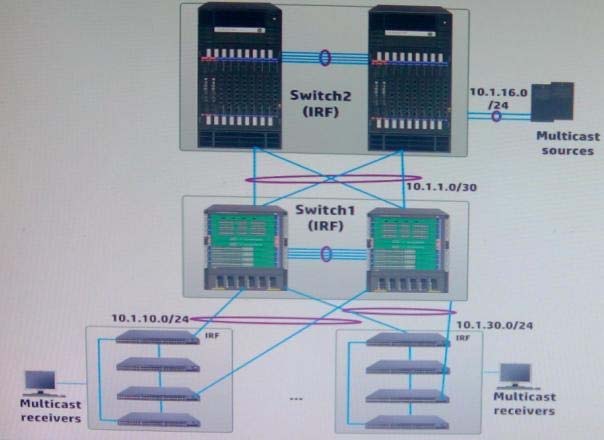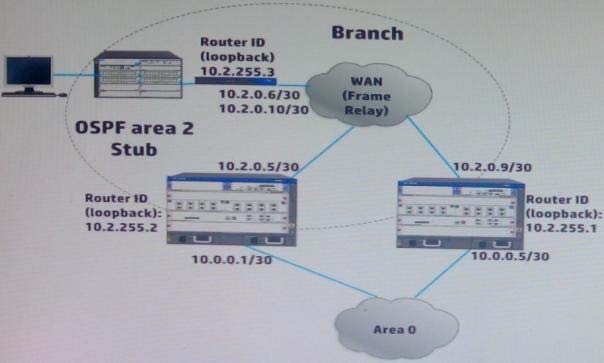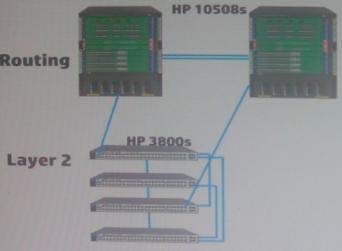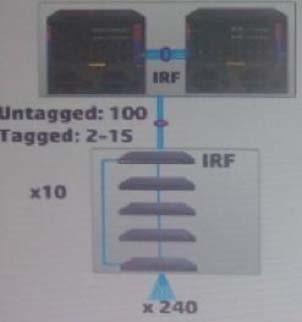HP HP0-Y50 Exam Practice Questions (P. 5)
- Full Access (133 questions)
- Six months of Premium Access
- Access to one million comments
- Seamless ChatGPT Integration
- Ability to download PDF files
- Anki Flashcard files for revision
- No Captcha & No AdSense
- Advanced Exam Configuration
Question #21
Refer to the exhibit.

All connections between switches are 10 Gbps. Switch is an Intelligent Resilient Framework (IRF) group with two member. Switch2 is an IRF group with two members. Switch1 and Switch2 route all traffic.
A network architect is designing a solution for a finance company. One of the primary applications is a multicast application that delivers stock information to IP video screens across the site. The network architect is seeking a multicast solution that meets these needs:
✑ Simple configuration that the customers IT staff can manage and troubleshoot
✑ No single point of failure for the multicast traffic
What is the best solution for this environment and these needs?

All connections between switches are 10 Gbps. Switch is an Intelligent Resilient Framework (IRF) group with two member. Switch2 is an IRF group with two members. Switch1 and Switch2 route all traffic.
A network architect is designing a solution for a finance company. One of the primary applications is a multicast application that delivers stock information to IP video screens across the site. The network architect is seeking a multicast solution that meets these needs:
✑ Simple configuration that the customers IT staff can manage and troubleshoot
✑ No single point of failure for the multicast traffic
What is the best solution for this environment and these needs?
- AProtocol Independent Multicast (PIM) Dense Mode (DM).
- BProtocol Independent Multicast (PIM) Sparse Mode (SM) with switch 1 and switch 2 configured as candidate Rendezvous Points (C-RPs), and switch1 and Switch2 also configured as Bootstrap Router (BSRs).
- CProtocol Independent Multicast (PIM) Dense Mode (DM) with Switch1 and Switch2 set as the DM Master Router. Switch1 has a higher MR priority for an address associated with the multicast application.
- DProtocol independent Multicast (PIM) Sparse Mode (SM) with switch1 and Switch2 set as the static Rendezvous Points (RPs). Switch1 has a higher RP priority
Correct Answer:
A
A
send
light_mode
delete
Question #22
Refer to the exhibit.

The branch routers have E1 lines into the Frame Relay Service provider network. The exhibit shows just one branch, but the network actually has 30 branches.
The HP 6600 Series routers, which are the area border routers (ABRs), have E2 lines into the Frame Relay network.
The routers in the exhibit Open Shortest Path First (OSPF). The enable OSPF on network follows:
✑ In area 2, OSPF is enabled on network 10.2.0.0/16
✑ In area 0, OSPF is enabled on network 10.0.0.0/16
The customer requires resilience at the WAN core. Which design change best supports that requirement?

The branch routers have E1 lines into the Frame Relay Service provider network. The exhibit shows just one branch, but the network actually has 30 branches.
The HP 6600 Series routers, which are the area border routers (ABRs), have E2 lines into the Frame Relay network.
The routers in the exhibit Open Shortest Path First (OSPF). The enable OSPF on network follows:
✑ In area 2, OSPF is enabled on network 10.2.0.0/16
✑ In area 0, OSPF is enabled on network 10.0.0.0/16
The customer requires resilience at the WAN core. Which design change best supports that requirement?
- AAdd additional links from the HP 6600 Series routers to the WAN
- BOn each branch router, add a floating static route to one of the ABRs in case the OSPF solution fails
- CAdd a Gigabit link between the HP 6600 Series router with a network in area 0 and area 2.
- DAt each branch, add a redundant link between the switch and the router
Correct Answer:
A
A
send
light_mode
delete
Question #23
Refer to the exhibit.

A network architect has planned redundant links as shown in the exhibit. What should the network architect do to ensure that the redundant link design is truly resilient?

A network architect has planned redundant links as shown in the exhibit. What should the network architect do to ensure that the redundant link design is truly resilient?
- AImplement the features such as link aggregation, backplane stacking, and intelligent Resilient Framework (IRF)
- BAdd another link between the Layer 2 switches and the core so that up to the two links can fail
- CImplement a feature such as bidirectional forwarding detection (BFO) on each redundant link
- DMake sure that each HP 10508 switch is configured as a root in one Multiple Spanning Tree Protocol (MSTP) instance
Correct Answer:
C
C
send
light_mode
delete
Question #24
A network architect is compiling information about the total cost ownership (TCO) for a proposal. Which factors play a role in TCO?
- ACost of remediation due to a future security breach
- BCost of regulatory fines associated with non-compliance
- CCost of upgrading modules for the proposal
- DCost of powering the solution
Correct Answer:
D
D
send
light_mode
delete
Question #25
Refer to the exhibit.

A network architect is designing the logical topology for a campus LAN networking solution. The customer requires support for 2400 edge ports, which is provided by 10 intelligent Resilient Framework (IRF) groups at the access layer. This customer does not have a wireless network nor anticipants adding one in the next two years. However, the customer does want to authenticate users with 802.1X and use the network RADIUS server to divide users from different groups into different
VLANs. The customer has three user groups, each of which includes between 600 and 900 users.
Additionally, the customer understands that the RADIUS server will require several policies but wants to keep these policies as simple and easy to maintain as possible.
How can the network architect ensure that the solution meets the customer needs and also follows best practice?

A network architect is designing the logical topology for a campus LAN networking solution. The customer requires support for 2400 edge ports, which is provided by 10 intelligent Resilient Framework (IRF) groups at the access layer. This customer does not have a wireless network nor anticipants adding one in the next two years. However, the customer does want to authenticate users with 802.1X and use the network RADIUS server to divide users from different groups into different
VLANs. The customer has three user groups, each of which includes between 600 and 900 users.
Additionally, the customer understands that the RADIUS server will require several policies but wants to keep these policies as simple and easy to maintain as possible.
How can the network architect ensure that the solution meets the customer needs and also follows best practice?
- AAssign a /23 subnet to each VLAN so that the VLAN can accommodate the required number of users, even if users connect multiple devices
- BPlan a different VLAN ID and subnet address for each user group on each access layer IRF group. Either core or access layer routing will work for this solution
- CUse access layer routing. Assign a different subnet to VLAN2 on one access layer IRF group then the VLAN2 on the another access layer group
- DPlan a solution for designing dissolvable agents to the endpoints so that they can complete 802.1X authentication seamlessly
Correct Answer:
B
B
send
light_mode
delete
All Pages
